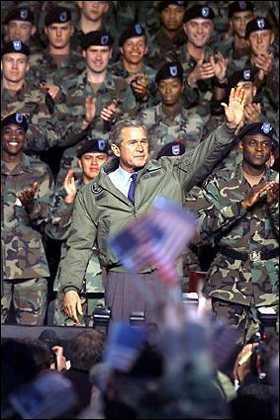 |
 |
| ROB T. ENNIS / KNIGHT RIDDER NEWSPAPERS |
| President Bush greets troops and their families at Fort Hood, Texas, this month, as they are deployed to the Gulf. |
 |
'AXIS OF EVIL'
U.S. threatens Iraq over weapons, but not Iran or North Korea.
U.S. foreign policy after Sept. 11, 2001 was clear-cut for awhile.
Islamist terrorists had attacked Americans at home, and America went after the perpetrators in their home base in Afghanistan.
But things have become more complicated, and even Washington insiders have been asking how the war against terror shifted suddenly from Osama bin Laden and his suicide bombers to the Middle Eastern totalitarian regime in Iraq.
President Bush angrily said that three countries — Iraq, Iran and North Korea — form an "axis of evil" that poses a threat to U.S. security far greater than bin Laden and his al-Qaida terrorists.
There are reasons for Americans to feel vulnerable to these three nations.
Iraq, Iran and North Korea all have worked to develop weapons of mass destruction — biological, nuclear and chemical weapons. All have connections with terrorist organizations that would use such weapons against U.S. targets.
Iraq's Saddam Hussein has used chemical weapons against rebellious minorities in his own country, so many people believe he would use them again himself or make them available to terrorists.
Saddam also launched unprovoked invasions against two neighbors, Iran and Kuwait. The war with Iran lasted eight years and depleted the Iraqi treasury. A U.S.-led international coalition intervened in Kuwait, ousting the Iraqis during the brief Gulf War.
TENUOUS LINKS
Commonly reported links between Saddam and al-Qaida are weak. Reports that an Iraqi minister met with Sept. 11 hijacker Mohamed Atta in Prague are disputed. Ramzi Yousef, convicted of the 1993 World Trade Center bombing that killed six people, entered the United States on an Iraqi passport as a refugee from Saddam after the Gulf War, and some U.S. officials believe he was an Iraqi intelligence agent.
Islamist bin Laden and the secular Saddam would never ally, some say, but others say that common hatred of the U.S. could easily bring them together.
"What happened on Sept. 11, as terrible as it was, is but a pale shadow of what will happen if terrorists use weapons of mass destruction," said Paul Wolfowitz, deputy secretary of defense and a leader of the hawks in the Bush administration. "Our approach has to aim at prevention and not merely punishment. We are at war."
Critics wonder why Bush jumped into this new phase of the war against terror so precipitously, and why Iraq is in the crosshairs while Iran and North Korea are on the sidelines.
Iraq clearly is the centerpiece of Bush's axis — hard-liners have wanted to make toppling Saddam the aim of foreign policy since Bush's father was president.
Still, some question the wisdom of turning the war on terror into the war against Iraq.
"The focus has really changed," Maya Chadda, a professor of political science at William Paterson University, said a few weeks after the "axis of evil" speech. "U.S. foreign policy has turned direction 180 degrees with the military as the spearhead to refashion the world and get rid of unfriendly regimes."
Secretary of State Colin Powell, who has been cool to the idea of going after Iraq, nevertheless maintains there is no policy change. "I think it's a good, clear message, but people get a little nervous sometimes when the Americans speak with such direct clarity."



